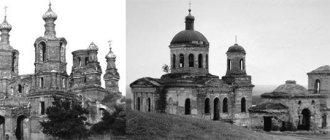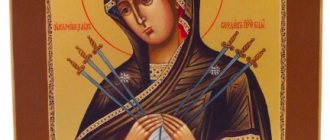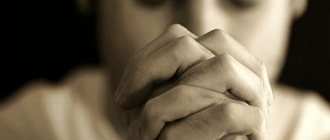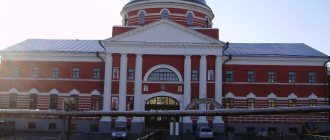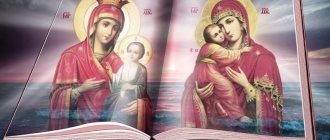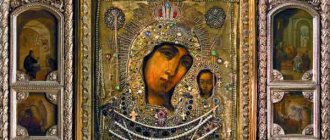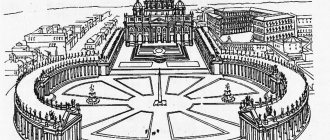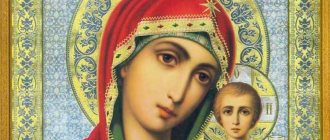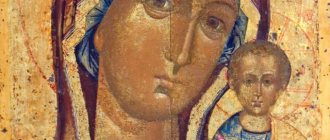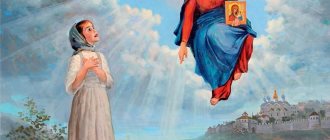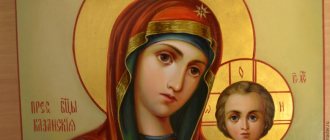The Kazan Icon was known to everyone in Russia - literate people and those who could not read, living in villages and cities, and even those who did not know where Kazan was - everyone prayed in front of it every day. The Kazan Icon of the Mother of God has always been revered and stood in the “red corner”.
In Russia, hundreds of churches were built in her honor, the largest Russian monastery in the Holy Land is dedicated to her - the Gornenskaya monastery in Jerusalem, and one of the lists is kept in Syria - in Damascus.
In the 20th century, the Catholic Church recognized the so-called Roman or Vatican list as its greatest shrine, which in 2004 was transferred to Patriarch Alexy II, and for the celebration of the 450th anniversary of the Kazan diocese on July 21, 2005, this image was brought to Kazan.
Story
On July 8, 1579, the greatest event for the entire Russian Orthodox Church took place - the miraculous icon of the Mother of God Hodegetria was found. The shrine received the name Kazan, in honor of the land from which it was extracted by the 10-year-old girl Matrona.
And if before 1552, at the word Kazan, many people felt fear, since this city was associated with Tatar raids and thousands of Russians taken prisoner, then after 1579 Kazan was perceived as a holy place where the Mother of God herself showed the greatest mercy.
In 1579, by decree of Tsar Ivan IV the Terrible, the Mother of God Convent was founded at the site of the appearance of the miraculous icon, and the girl Matrona accepted monasticism and became Martha, the abbess of the monastery.
Since then, July 8 is the Day of celebration of the Kazan Mother of God, and her second holiday is October 22, according to the new style - November 4, established in memory of the events of 1612, when faith in victory and the miraculous Kazan icon helped to defeat the Polish invaders . The miraculous icon was returned to the monastery after the campaign of 1612.
In 1904, on the night of June 28, a tragedy occurred for the entire Orthodox people of Russia - the greatest shrine was stolen by the thief Chaikin and his accomplices. They only wanted precious stones, but they cut and burned the shrine. This happened a year before the terrible events approaching the country, and this tragedy became a harbinger of wars and revolutions that soon came to Russia. By that time the number of nuns in the monastery was about 500.
For several more years, the monastery’s churches served Orthodoxy, but in the 20s of the last century, a student dormitory was placed in the living quarters of the monastery, and a granary was located in the cathedral. In 1929 the Church of the Exaltation of the Cross was closed, in 1930 all the bells were removed and the destruction and ruin of all the buildings of the monastery began.
In 1942, a tobacco factory was located on the territory of the monastery; in the 60s of the last century, five-story buildings were built on the site of the blown up bell tower, which still stand today.
In 1994, the small St. Sophia Church opened, and 10 years later the revival of the Bogoroditsky Monastery began. On July 21, 2005, in the Church of the Exaltation of the Cross, with the participation of His Holiness Patriarch Alexy II of Moscow and All Rus' and 12 bishops, the miraculous Vatican list of the shrine was donated to the Kazan diocese. Currently, divine services are held in the temple every day and religious processions are held here 14 times a year.
Time scatters stones
But the revolution broke out, and already in the fall of 1918, by order of the authorities, the Kazan Kremlin with all its churches was closed. The greatest shrines of Orthodoxy - the relics of Saints Guria and Barsanuphius of Kazan - were transferred to the nearby Bogoroditsky Monastery.
Thus, all the main shrines of the city were collected in it. But later it was also abolished.
In order to somehow preserve the building, the Orthodox community was officially registered in it. A little later, she was moved to the Peter and Paul Cathedral. Now no one and nothing could prevent the destruction and looting of temples.
The residential premises housed a student dormitory, which, of course, contributed to the deterioration of their conditions: some doors and also windows were completely broken, as if they had not existed at all. Numerous staircase steps and railings were burned for firewood, and many monuments and sculptures in the courtyard were barbarically smashed.
In one of the temples there was a grain warehouse; it was poured right in front of the ancient iconostasis. The bells were removed from the bell tower, and, by decision of the authorities, it was decided to blow up the main cathedral. This happened in 1931.
At one time, a film studio was built in the courtyard of the monastery, but the work was not completed. And a tobacco factory was installed in empty buildings. And where the monastery cemetery was recently located, new residential buildings appeared.
During the war with the Nazis, the Church of the Exaltation of the Cross was refurbished, and people lived there, which ultimately led to its final ruin.
Architecture of the Kazan-Bogoroditsky Monastery
The monastery occupied an area of several hectares, and in its size and luxury it had no equal in the entire Volga region. At the beginning of the 19th century, among its main buildings were the following:
The cathedral, built in 1798–1808 according to the design of the famous architect Ivan Yegorovich Starov, the founder of classicism in Russian architecture and the creator of the Trinity Cathedral of the Alexander Nevsky Lavra, as well as many other palaces and temples. The size of the cathedral was 43 by 49 meters, and the height was 40 meters, it had five hemispherical domes and three pediments with columns. Restored in 2021.
St. Nicholas Church was built in 1810–1816 and was located north of the cathedral and had one hemispherical dome.
The Church of the Exaltation of the Cross with a hemispherical dome was located south of the cathedral and was created in 1882–1884.
The Rector's and St. Nicholas buildings made up a huge semicircular building; these buildings were created in the 1810–1840s.
The bell tower is 55 meters high, built in the mid-17th century.
Small gateway St. Sophia Church of the 17th century.
Kazan Icon: How the Mother of God Helps
Kazan Icon of the Mother of God. Moscow, first half of the 18th century.
According to the teachings of the Orthodox Church, one cannot assume that this or that icon helps with anything. Metropolitan Anthony of Sourozh said that a newly painted image becomes a shrine only after its consecration. Until this point, the new icon is simply an image of Christ, the Mother of God or a saint, which is made with paints on wood. Christians do not worship the material with which this or that image is painted. At the VII Ecumenical Council, the dogma of icon veneration was adopted. It directly states that “the honor given to the image passes to the original, and the one who worships the icon worships the being depicted on it.”
Another thing is that some icons are considered miraculous, since Christ, through prayers in front of certain shrines, helps people and entire nations. Therefore, the Kazan Icon of the Mother of God was especially revered in Rus', and the Mother of God, through the prayers of people in front of her image, more than once healed the sick or saved the country from destruction.
Prayer before the icon of the Kazan Mother of God has saved Russia more than once. This was the case at the beginning of the 17th century, when Moscow was captured by the Poles. In the militia of Minin and Pozharsky there was a miraculous image of the Mother of God, and after fervent prayers people were able to liberate the Kremlin from the invaders in 1613.
In 1812, Russia was attacked by Napoleon’s army, and again prayer in front of the image of the Kazan Mother of God helped to cope with the invaders. The army of thousands of the famous commander fled from Russia.
The same thing happened during the Great Patriotic War. There are several stories about how the Mother of God helped people survive the horrors of war, and soldiers helped defeat a terrible enemy. Prayer helped soldiers in battles.
_________________________________________________________
Interesting Facts
- Most residents of St. Petersburg believe that the list located in the Kazan Cathedral is the original of 1579. The St. Petersburg list is more than twice the size of the shrine found in 1579, the size of which is 6 by 5 vershoks, and the St. Petersburg one is 13.5 by 12 vershoks and it was made later - at the end of the 17th century by order of Praskovya Fedorovna, the widow of the deceased in the youth of Tsar Ivan Alekseevich, brother of Peter I. Until 1918, Muscovites also believed that they had the original. The Moscow list was one of the three most revered, along with the Kazan first-appeared image and the later St. Petersburg list
- Since 2005, the monastery has been revived as a male monastery, although previously it was female. His brethren are small and number a few people
- It should be noted that a copy of a revered icon is called a list in icon painting. Since the icon is considered a manifestation of Divine truth, and the icon painter, when creating the image, plays the role of only an intermediary - a conductor of this truth, the list has all the properties of the icon and has the same name. Therefore, the question of authenticity for an icon does not exist; every canonical icon is authentic, since it points to the Divine prototype.
Reconstruction
Only part of the buildings of the entire architectural complex have survived to this day, the oldest of which was the St. Sophia Shrine. Several buildings have never been repaired; the warm church of St. Nicholas of Tula and the original fence towers have completely dilapidated.
St. Sophia Church, © Disciple
The only relatively preserved building is the Church of the Exaltation of the Cross, where the Vatican copy of the Kazan Icon of the Mother of God was transferred in 2005.
Over the past few years, restoration work has been going on in some of the buildings on the territory of the former monastery. During this time, the gate church of St. Sophia, which was re-consecrated in 1994, was brought back to life. It cannot boast of rich interior decoration; there are only a few icons donated by other churches and a modern iconostasis. In the future, beautiful frescoes on the walls, which were once destroyed, will be recreated. The parishioners of the church and its members have hope that what remains of the cave temple will be found, and the Kazan Cathedral itself will be restored. Also, as a result of restoration work, they plan to restore the Mother of God Cathedral.
After the restoration of the Holy Cross Corps in 2005, it began its work again. Divine services are held here every day, the place is open at other times for all believers and tourists. In the winter of 2007, the holy monastery was given the status of a monastery, and now its head is Hieromonk Pitirim.
Troparion of the Kazan Icon
Troparion of the Kazan Icon of the Mother of God, tone 4
Zealous intercessor, Mother of the Most High Lord. Pray for all, thy Son Christ our God, and cause all to be saved, into thy sovereign protection for those who flee. Intercede for us all, O Lady Queen and Lady! even in adversity and sorrow, and in illness, burdened with many sins, coming and praying to you with a tender soul and a contrite heart, before your most pure image with tears, and irrevocably hope I am waiting for those who have it, for the deliverance of all evils. Grant what is useful to everyone, and save everything, O Virgin Mary: for you are the divine protection of your servant.
Prayer before the Kazan Icon
Prayer before the Icon of the Mother of God “Kazan” (October 22/November 4 and July 8/21)
O Most Holy Lady Theotokos! With fear, faith and love before Your honest (and miraculous) icon, we pray to You: do not turn Your face away from those who come running to You. Pray, merciful Mother, to Thy Son and our God, the Lord Jesus Christ, to keep our country peaceful, and to keep His Holy Church unshakable from unbelief, heresies and schism let him deliver. There are no other help, no other hope, except You, Most Pure Virgin: You are the all-powerful Helper and Intercessor of Christians. Deliver all those who pray to You with faith from the falls of sin, from the slander of evil people, from all temptations, sorrows, illnesses, troubles and from sudden death. Grant us the spirit of contrition, humility of heart, purity of thoughts, correction of sinful lives and the remission of sins, and all of us, gratefully chanting Your greatness and mercy, which are revealed to us here on earth , let us be worthy of the Heavenly Kingdom, and there with all the saints we will glorify the most honorable and magnificent name Father, and Son, and Holy Spirit forever and ever. Amen.
